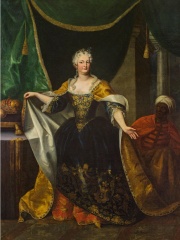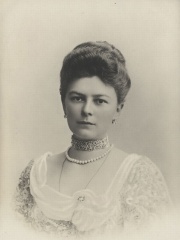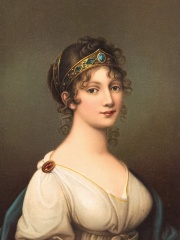
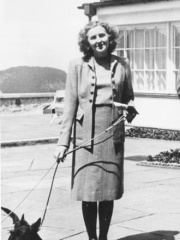
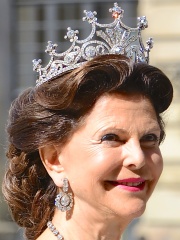
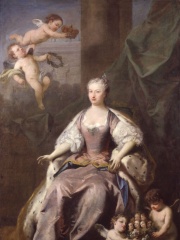
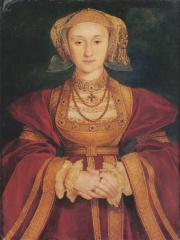
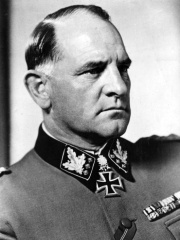

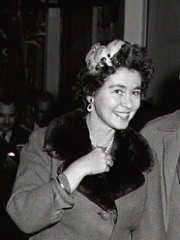
The Most Famous
COMPANIONS from Germany
This page contains a list of the greatest German Companions. The pantheon dataset contains 784 Companions, 111 of which were born in Germany. This makes Germany the birth place of the most number of Companions.
Top 10
The following people are considered by Pantheon to be the top 10 most legendary German Companions of all time. This list of famous German Companions is sorted by HPI (Historical Popularity Index), a metric that aggregates information on a biography's online popularity. Visit the rankings page to view the entire list of German Companions.

1. Empress Elisabeth of Austria (1837 - 1898)
With an HPI of 89.61, Empress Elisabeth of Austria is the most famous German Companion. Her biography has been translated into 72 different languages on wikipedia.
Elisabeth (Elisabeth Amalie Eugenie; German: [eˈliːzaˌbɛt aˈmaːliə ɔʏˈɡeːniə]; 24 December 1837 – 10 September 1898), nicknamed Sisi or Sissi, was Empress of Austria and Queen of Hungary from her marriage to Franz Joseph I on 24 April 1854 until her assassination in 1898. Elisabeth was born into the Bavarian House of Wittelsbach but enjoyed an informal upbringing before marrying her first cousin, Emperor Franz Joseph I, at 16. The marriage thrust her into the much more formal Habsburg court life, for which she was unprepared and which she found suffocating. The couple had four children: Sophie, Gisela, Rudolf, and Marie Valerie. Early in her marriage, Elisabeth was at odds with her aunt and mother-in-law, Archduchess Sophie, who took over the rearing of Elisabeth's children. The birth of a son, Rudolf, improved Elisabeth's standing at court, but her health suffered under the strain. As a result, she would often visit Hungary for its more relaxed environment. She came to develop a deep kinship with Hungary and helped to bring about the dual monarchy of Austria-Hungary in 1867. The death of Crown Prince Rudolf and his mistress Baroness Mary Vetsera in a murder–suicide at his hunting lodge at Mayerling in 1889 was a blow from which Elisabeth never fully recovered. She withdrew from court duties and travelled widely, unaccompanied by her family. In 1890, she had the palace Achilleion built on the Greek island of Corfu. The palace featured an elaborate mythological motif and served as a refuge, which Elisabeth visited often. She was obsessively concerned with maintaining her youthful figure and beauty, developing a restrictive diet and wearing extremely tightlaced corsets to keep her waist looking very small. While travelling in Geneva in 1898, Elisabeth was fatally stabbed in the heart by an Italian anarchist named Luigi Lucheni. Her tenure of 44 years was the longest of any Austrian empress.

2. Eva Braun (1912 - 1945)
With an HPI of 82.22, Eva Braun is the 2nd most famous German Companion. Her biography has been translated into 81 different languages.
Eva Anna Paula Hitler (née Braun; 6 February 1912 – 30 April 1945) was a German photographer who was the longtime companion and briefly the wife of Adolf Hitler. Braun met Hitler in Munich in 1929 (aged 17) when she was an assistant and model for his personal photographer, Heinrich Hoffmann. She began seeing Hitler often about two years later. She attempted suicide twice during their early relationship. By 1936, Braun was a part of Hitler's household at the Berghof near Berchtesgaden, Bavaria, Germany, and lived a sheltered life throughout World War II. She became a significant figure within Hitler's inner social circle, but did not attend public events with him until mid-1944, when her sister Gretl married Hermann Fegelein, the SS liaison officer on his staff. As Nazi Germany was collapsing towards the end of the war, Braun swore loyalty to Hitler and went to Berlin to be by his side in the heavily reinforced Führerbunker beneath the Reich Chancellery garden. As Red Army troops fought their way into the centre government district, on 29 April 1945, Braun married Hitler during a brief civil ceremony; she was 33 and he was 56. Less than 40 hours later, they died by suicide in a sitting room of the bunker: Braun by biting and swallowing a capsule of cyanide, and Hitler by a gunshot to the head. Much of the German public was unaware of Braun's relationship with Hitler until after their deaths. She created many of the surviving colour photographs and films of Hitler.

3. Queen Silvia of Sweden (b. 1943)
With an HPI of 78.26, Queen Silvia of Sweden is the 3rd most famous German Companion. Her biography has been translated into 52 different languages.
Silvia (born Silvia Renate Sommerlath; 23 December 1943) is Queen of Sweden as the wife of King Carl XVI Gustaf. She has held this title since her marriage to Carl XVI Gustaf in 1976. The king and queen have three children: Crown Princess Victoria, Prince Carl Philip, and Princess Madeleine.

4. Caroline of Ansbach (1683 - 1737)
With an HPI of 77.65, Caroline of Ansbach is the 4th most famous German Companion. Her biography has been translated into 43 different languages.
Caroline of Brandenburg-Ansbach (Wilhelmina Charlotte Caroline; 1 March 1683 – 20 November 1737) was Queen of Great Britain and Ireland and Electress of Hanover from 11 June 1727 (O.S.) until her death in 1737 as the wife of King George II. Caroline's father, Margrave John Frederick of Brandenburg-Ansbach, belonged to a branch of the House of Hohenzollern and was the ruler of a small German state, the Principality of Ansbach. After Caroline was orphaned at a young age, she moved to the enlightened court of her guardians, King Frederick I and Queen Sophia Charlotte of Prussia. At the Prussian court, her previously limited education was widened and she adopted the liberal outlook possessed by Sophia Charlotte, who became her good friend and whose views influenced Caroline all her life. When she was a young woman, Caroline was much sought after as a bride. After rejecting the suit of Archduke Charles of Austria, a claimant to the Spanish throne, she married George Augustus, who was third in line to the English throne (and subsequently the British throne) and heir apparent to the Electorate of Hanover. They had eight children, seven of whom reached adulthood. Caroline moved to Britain permanently in 1714 when her husband became Prince of Wales. As Princess of Wales she joined George Augustus in rallying political opposition to his father, King George I. In 1717, after a family row, George Augustus was expelled from court. Caroline came to be associated with Robert Walpole, an opposition politician who was a former government minister. Walpole rejoined the government in 1720, and George Augustus reconciled publicly with his father on Walpole's advice. Over the next few years Walpole rose to become the leading minister. Upon her husband's accession in 1727, Caroline became queen and electress, and her eldest son, Frederick, became Prince of Wales. He was a focus for the opposition, like his father before him, and Caroline's relationship with him was strained. As princess and as queen, Caroline was known for her political influence, which she exercised both through and for Walpole. Her tenure included four regencies, which occurred during George II's stays in Hanover; she is credited with strengthening the House of Hanover's place in Britain during a period of political instability. After her death in 1737, Caroline was widely mourned by her political allies as well as by the King, who refused to remarry.
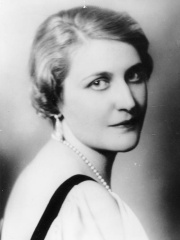
5. Magda Goebbels (1901 - 1945)
With an HPI of 76.09, Magda Goebbels is the 5th most famous German Companion. Her biography has been translated into 43 different languages.
Johanna Maria Magdalena Goebbels (née Ritschel; 11 November 1901 – 1 May 1945) was the wife of Nazi Germany's propaganda minister Joseph Goebbels. A prominent member of the Nazi Party, she was a close ally, companion, and political supporter of Adolf Hitler. Some historians refer to her as the unofficial "first lady" of Nazi Germany, while others give that title to Emmy Göring. With defeat imminent during the Battle of Berlin at the end of World War II in Europe, she and her husband murdered their six children with a cyanide compound before committing suicide in the Reich Chancellery gardens. Her eldest son, Harald Quandt, from a previous marriage to Günther Quandt, survived her.

6. Anne of Cleves (1515 - 1557)
With an HPI of 75.79, Anne of Cleves is the 6th most famous German Companion. Her biography has been translated into 62 different languages.
Anne of Cleves (German: Anna von Kleve; 28 June or 22 September 1515 – 16 July 1557) was Queen of England from 6 January to 12 July 1540 as the fourth wife of Henry VIII. Born in Düsseldorf to the House of La Marck, little is known about Anne before 1527, when she became betrothed to Francis, Duke of Bar, son and heir of Antoine, Duke of Lorraine, although their marriage did not proceed. In March 1539, negotiations for Anne's marriage to Henry began. Henry believed he needed to form a political alliance with her brother, William, Duke of Jülich-Cleves-Berg, a leader of the Protestants of Western Germany, to strengthen his position against potential attacks from Catholic France and the Holy Roman Empire. Anne arrived in England in December 1539 and married Henry a week later, but the marriage was declared unconsummated after six months and Anne was not crowned queen consort. Following the annulment, Henry gave her a generous settlement and Anne was thereafter known as the King's Beloved Sister. Remaining in England, she lived to see the reigns of Henry's children, Edward VI and Mary I, and attended Mary's coronation in 1553. Anne outlived the rest of Henry's wives. Upon her death she was interred as a queen in Westminster Abbey.

7. Sepp Dietrich (1892 - 1966)
With an HPI of 75.24, Sepp Dietrich is the 7th most famous German Companion. His biography has been translated into 40 different languages.
Josef "Sepp" Dietrich (28 May 1892 – 21 April 1966) was a German politician, general and war criminal in the Schutzstaffel (SS) during the Nazi era. Despite having no formal staff officer training, Dietrich was, along with Paul Hausser, the highest-ranking officer in the Waffen-SS, the military branch of the SS. He joined the Nazi Party in 1928 and was elected to the Reichstag of the Weimar Republic in 1930. Prior to 1929, Dietrich was Adolf Hitler's chauffeur and bodyguard. Reaching the rank of SS-Oberst-Gruppenführer, he commanded units up to army level during World War II. As commanding officer of the 6th Panzer Army during the Battle of the Bulge, Dietrich bore responsibility for the Malmedy massacre, the murder of U.S. prisoners of war in December 1944. After the war, an American military tribunal convicted Dietrich of war crimes at the Malmedy massacre trial. Upon his release from Landsberg Prison in 1955, Dietrich became active in HIAG, a lobby group established by former high-ranking Waffen-SS personnel. He died in 1966.

8. Isabeau of Bavaria (1370 - 1435)
With an HPI of 75.11, Isabeau of Bavaria is the 8th most famous German Companion. Her biography has been translated into 46 different languages.
Isabeau of Bavaria (or Isabelle; also Elisabeth of Bavaria-Ingolstadt; c. 1370 – 24 September 1435) was Queen of France as the wife of King Charles VI from 1385 to 1422. She was born into the House of Wittelsbach as the only daughter of Duke Stephen III of Bavaria-Ingolstadt and Taddea Visconti of Milan. At age 15 or 16, Isabeau was sent to France to marry the young Charles VI; the couple wed three days after their first meeting. Isabeau was honored in 1389 with a lavish coronation ceremony and entry into Paris. In 1392, Charles suffered the first attack of what was to become a lifelong and progressive mental illness, resulting in periodic withdrawal from government. The episodes occurred with increasing frequency, leaving a court both divided by political factions and steeped in social extravagances. A 1393 masque for one of Isabeau's ladies-in-waiting—an event later known as Bal des Ardents—ended in disaster with Charles almost burning to death. Although the King demanded Isabeau's removal from his presence during his illness, he consistently allowed her to act on his behalf. In this way she became regent to the Dauphin of France (heir apparent), and sat on the regency council, allowing her far more power than was usual for a medieval queen consort. Charles' illness created a power vacuum that eventually led to the Armagnac–Burgundian Civil War between supporters of his brother Louis I, Duke of Orléans, and the royal dukes of Burgundy, Philip the Bold and John the Fearless. Isabeau shifted allegiances as she chose the most favorable paths for the heir to the throne. When she followed the Armagnacs, the Burgundians accused her of adultery with the Duke of Orléans; when she sided with the Burgundians, the Armagnacs removed her from Paris and she was imprisoned. In 1407, John the Fearless assassinated Orléans, sparking hostilities between the factions. The war ended soon after Isabeau's son Charles had John assassinated in 1419—an act that saw him disinherited. Isabeau attended the 1420 signing of the Treaty of Troyes, which decided that the English king should inherit the French crown after the death of her husband. She lived in English-occupied Paris until her death in 1435. Isabeau was popularly seen as a spendthrift and irresponsible philanderess. In the late 20th and early 21st centuries historians re-examined the extensive chronicles of her lifetime, concluding that many unflattering elements of her reputation were unearned and stemmed from factionalism and propaganda.

9. Frederica of Hanover (1917 - 1981)
With an HPI of 75.08, Frederica of Hanover is the 9th most famous German Companion. Her biography has been translated into 38 different languages.
Frederica of Hanover (German: Friederike Luise; Greek: Φρειδερίκη Λουΐζα, romanized: Phreideríkē Louḯza; 18 April 1917 – 6 February 1981) was Queen of Greece from 1 April 1947 until 6 March 1964 as the wife of King Paul and the Queen Mother of Greece from 6 March 1964, when her son Constantine II became King, until 8 December 1974, when the monarchy was officially abolished after a referendum. Granddaughter of Kaiser Wilhelm II and daughter of Duke Ernest Augustus of Brunswick, Frederica was born a few months before the fall of the German Empire. Her family overthrown, she grew up between Austria and Weimar Germany, where her father owned large properties. As a teenager, she joined the Hitler Youth in 1933, before leaving to complete her studies for the next two years in the United Kingdom and then Italy. In Florence, she was received by Princess Helen of Greece and Denmark, at whose house she met the Crown Prince of Greece, Paul. The two fell in love and married two years after the restoration of the monarchy in Greece. In the years that followed, she gave birth to three children, Sophia in 1938, Constantine in 1940 and Irene in 1942. During the Second World War, Greece was occupied by the Axis powers. The Greek royal family left the country and Frederica and her children settled first in South Africa and from 1943 in Egypt. The changing political situation in Greece, with the rise of the EAM and the KKE, challenged the institution of the monarchy. The royal family did not return to the country until 1946, when the Greeks ratified the return and restoration of the institution in a referendum. In the period of civil war that followed, Frederica developed a strong social activity to support the efforts of the government and the Crown. She organised a network to help refugees affected by the forces of the Democratic Army, creating the so-called "children's towns", an initiative that was widely criticised by opponents of the Crown. After the death of Paul I in 1964, the dowager queen retired from public life. However, according to the prevailing historiographical view, she continued to influence the fate of the country through her son, now King Constantine II. Frederica was widely regarded as Constantine's éminence grise and continued to be attacked by the opposition, who blamed her for the tensions between the palace and the government of Georgios Papandreou (1964–1965).

10. Katharina von Bora (1498 - 1552)
With an HPI of 74.61, Katharina von Bora is the 10th most famous German Companion. Her biography has been translated into 45 different languages.
Katharina von Bora (German: [kataˈʁiːnaː fɔn ˈboːʁaː]; 29 January 1499? – 20 December 1552), after her wedding Katharina Luther, also referred to as "die Lutherin" ('the Lutheress'), was the wife of the German reformer Martin Luther and a seminal figure of the Protestant Reformation. Although little is known about her, she is often considered to have been important to the Reformation, her marriage setting a precedent for Protestant family life and clerical marriage.
People
Pantheon has 111 people classified as German companions born between 765 and 1967. Of these 111, 2 (1.80%) of them are still alive today. The most famous living German companions include Queen Silvia of Sweden, and Gloria, Princess of Thurn and Taxis. The most famous deceased German companions include Empress Elisabeth of Austria, Eva Braun, and Caroline of Ansbach.
Living German Companions
Go to all RankingsQueen Silvia of Sweden
1943 - Present
HPI: 78.26
Gloria, Princess of Thurn and Taxis
1960 - Present
HPI: 51.83
Deceased German Companions
Go to all RankingsEmpress Elisabeth of Austria
1837 - 1898
HPI: 89.61
Eva Braun
1912 - 1945
HPI: 82.22
Caroline of Ansbach
1683 - 1737
HPI: 77.65
Magda Goebbels
1901 - 1945
HPI: 76.09
Anne of Cleves
1515 - 1557
HPI: 75.79
Sepp Dietrich
1892 - 1966
HPI: 75.24
Isabeau of Bavaria
1370 - 1435
HPI: 75.11
Frederica of Hanover
1917 - 1981
HPI: 75.08
Katharina von Bora
1498 - 1552
HPI: 74.61
Elisabeth Christine of Brunswick-Wolfenbüttel
1691 - 1750
HPI: 74.41
Sophie, Duchess of Hohenberg
1868 - 1914
HPI: 74.38
Louise of Mecklenburg-Strelitz
1776 - 1810
HPI: 73.78
Overlapping Lives
Which Companions were alive at the same time? This visualization shows the lifespans of the 25 most globally memorable Companions since 1700.


